Torrijas, pronounced “torr-reh-has,” transforms day-old bread into a sweet honey, citrus, and cinnamon-scented treat everyone will love. In this Spanish version of French toast, thick slices of day-old bread are soaked in sweetened milk until soft and custardy and flavored with cinnamon and citrus then fried in extra virgin olive oil (rather than butter) for a slightly lighter brunch, dessert, or afternoon indulgence.
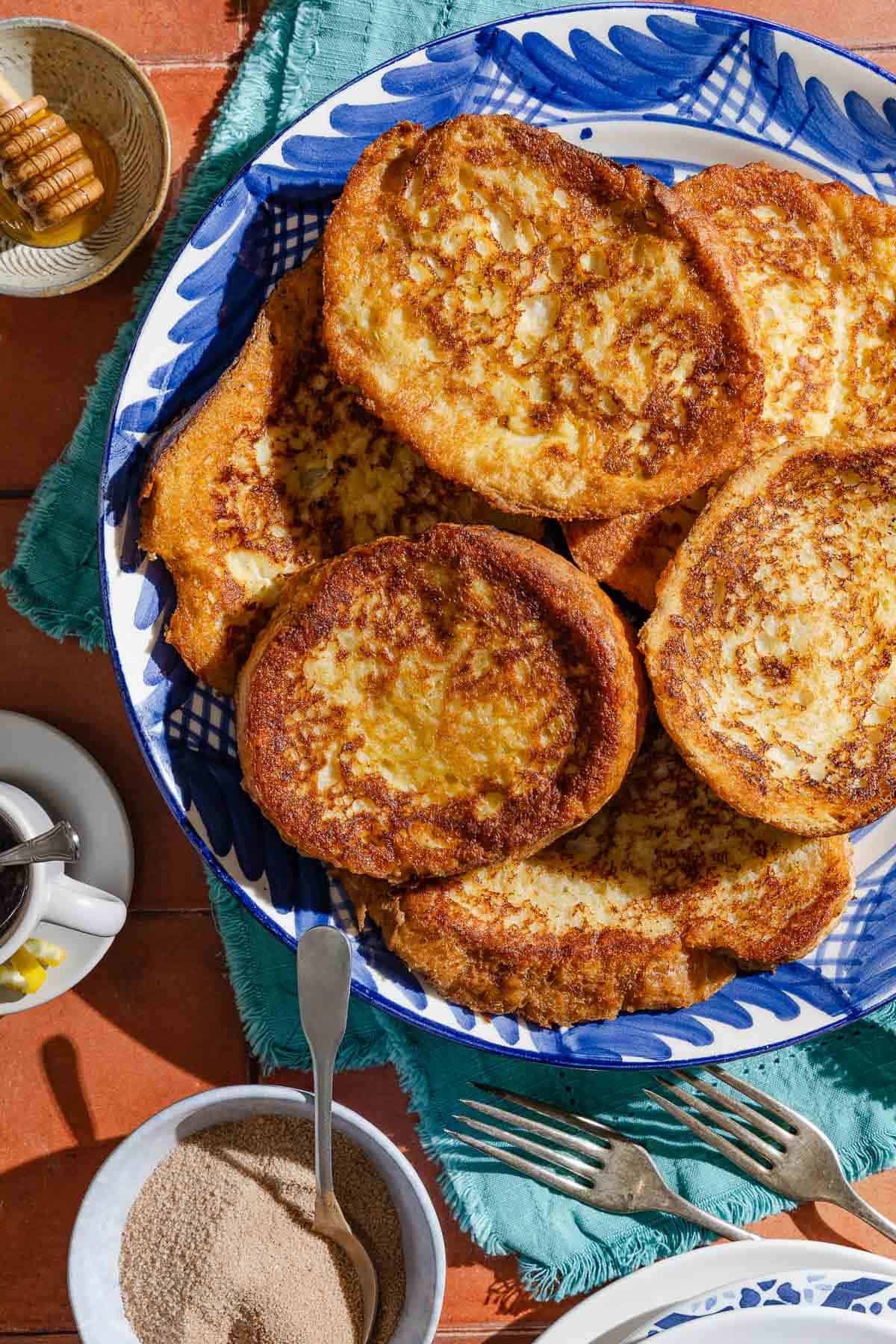
Semana Santa, or holy week, in Spain, is a monumental event. Even for the non-religious, it’s a cultural phenomenon with a long history. During this last week of Lent, convents, bakeries, and home cooks prepare sweets like buñuelos (dough fritters), huesos de San Expedito (bone-shaped pastries), and mona de Pasqua (a cake traditionally made with hard-boiled eggs, not unlike Italian Easter Bread).
The most famous treat served during Semana Santa is torrijas. Torrijas are the Spanish counterpart to French Toast. Thick slices of day-old bread are soaked in sweetened milk flavored with cinnamon, lemon and orange then pan-fried in olive oil. While they’re still warm, the slices are coated with cinnamon sugar. I like them best when they’re still hot from the pan, but they’re also sold from bakeries at room temperature to enjoy on the go.
Torrijas are a staple of Semana Santa in all of Spain but there are many variations depending on the region and even the household. In the south, they’re often deep-fried and drizzled with honey. Elsewhere they’re pan-fried and coated with cinnamon sugar. Sometimes torrijas are soaked in a syrup made with sugar and cinnamon, honey, or molasses.
The deep-fried torrijas are worth a stop by a bakery, but at home, I like the lighter version cooked in a pan and sprinkled with cinnamon sugar. Inspired by those drizzled or soaked in syrup, I add a little honey directly to the milk the bread soaks in for the flavor without being overly sweet.
Table of Contents
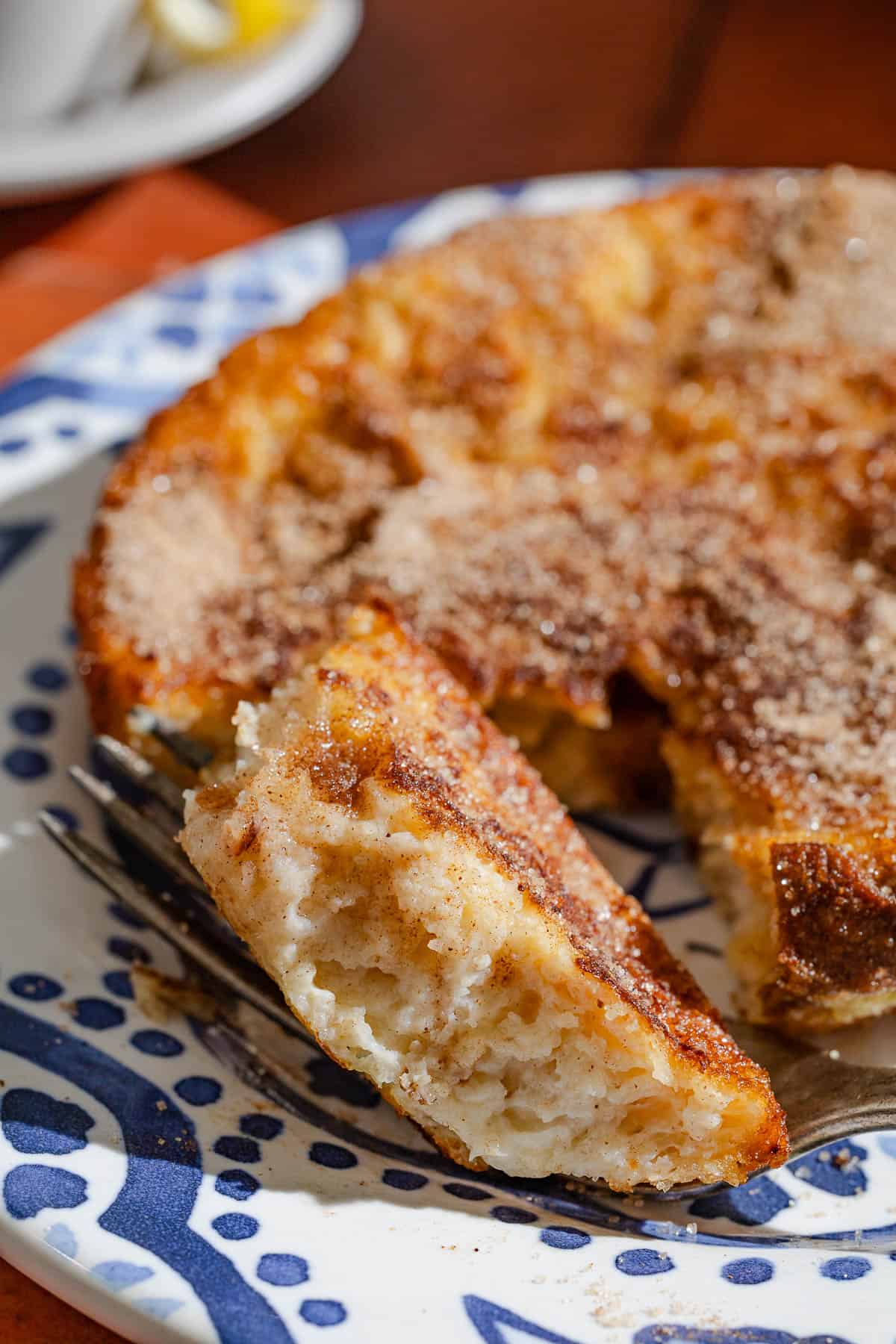
Difference Between Torrijas and French Toast
Torrijas are very similar to French toast, but they’re not quite as rich. To make French toast, stale bread soaks in a mix of milk and eggs before cooking in a pan with butter (or sometimes people make baked French toast for an easier twist).
It’s usually served with more butter and syrup. Both recipes come out of a desire to make good use of old bread, but because Spain has historically been poorer, they used fewer expensive ingredients like eggs or butter for torrijas.
Torrijas soak in a large amount of warm, sweetened milk infused with cinnamon and citrus peel. Only after the bread has soaked as much of the milk as possible is it coated in beaten egg and pan-fried in olive oil. French toast tends to retain more of a bready texture but with the extra milk, torrijas have a creamier, more custardy interior.
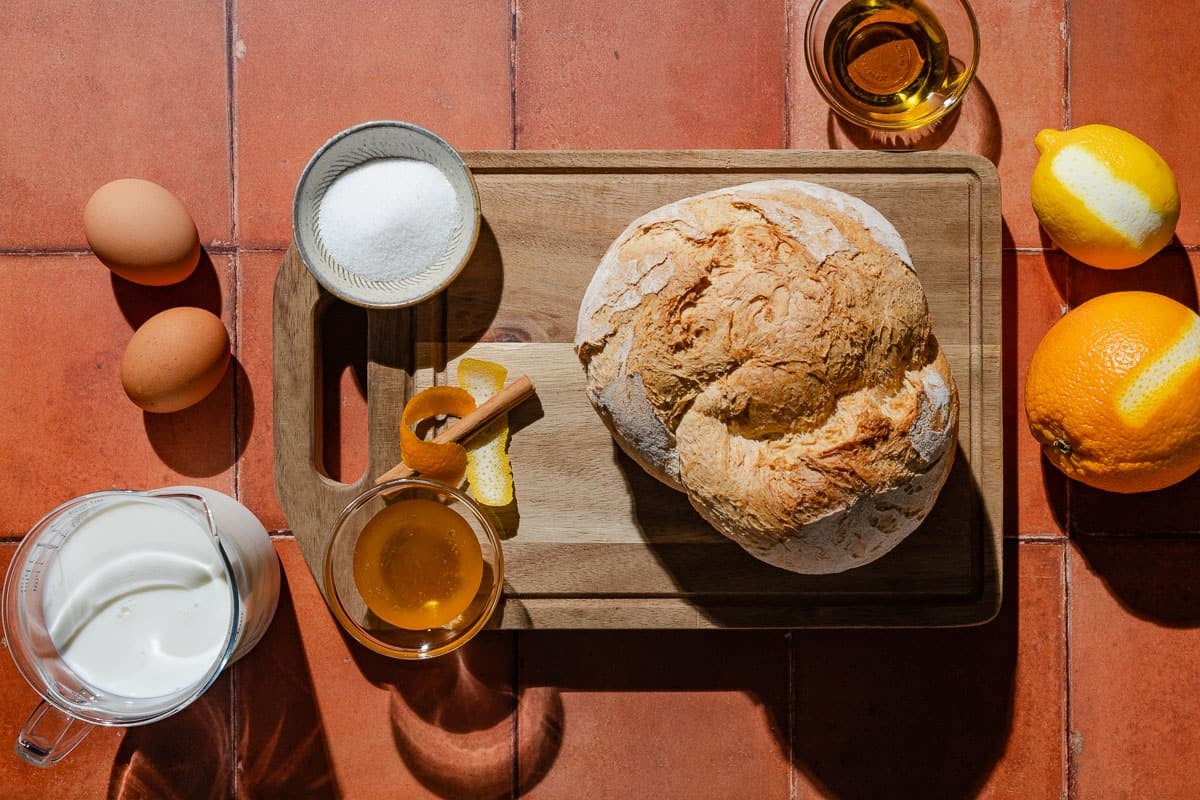
Ingredients for Torrijas
Torrijas were originally created to make use of stale bread. With these humble origins, all the ingredients are pantry staples.
- Bread: Day-old or stale bread works best so the slices can soak up the milk without breaking apart. You can use any type of bread, but crusty white bread with a fine crumb works best. If you only have fresh bread, you can dry the slices at 300°F for 10 to 15 minutes.
- Milk: Whole milk makes the creamiest torrijas, but you can also use 2% or even unflavored, unsweetened plant-based milk.
- Honey: Some regions of Spain drizzle or soak torrijas with syrup or honey after cooking, but I love adding some honey directly to the milk for extra flavor. (You can stock up on our favorite Greek honey over at our shop!)
- Granulated sugar: A little sugar sweetens the milk for soaking the bread and some is also used to make cinnamon sugar.
- Cinnamon: I can’t think of many Spanish desserts without cinnamon and citrus. It’s a classic combo that will never get old.
- Citrus peel: You can use either a lemon, orange, or both. Use a vegetable peeler to peel a thin, wide strip. Scrape off any of the bitter white piths with a paring knife.
- Eggs: Eggs help with browning for a golden crust on the toast.
- Extra virgin olive oil: Some fancier restaurants have started making a richer version with butter, but olive oil is the traditional way to fry torrijas, and it adds a nice nuance in terms of flavor. Try our Spanish Hojiblanca for a slightly peppery note.
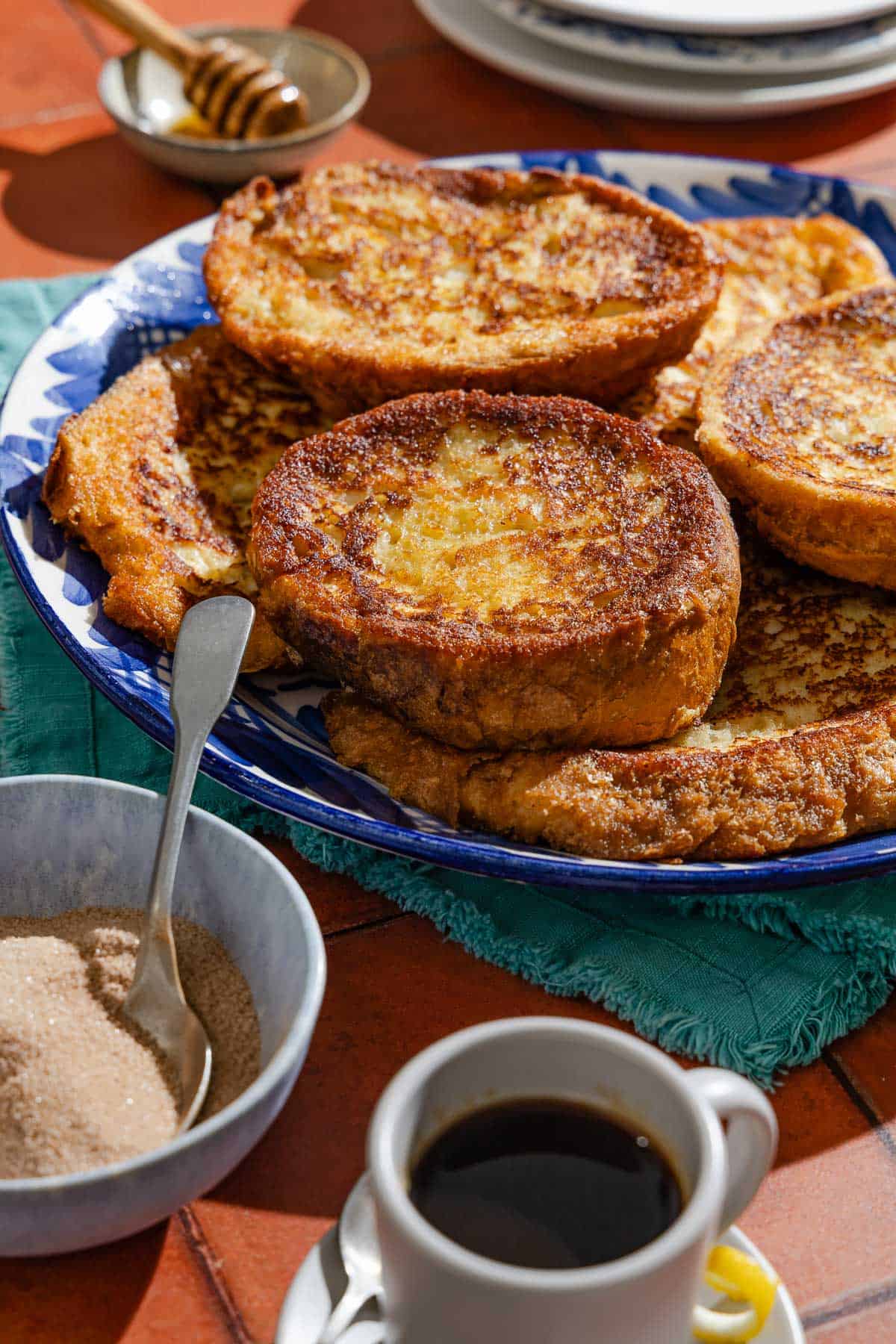
How to Make Torrijas
Torrijas are simple to make, but they do require an hour to infuse the milk and to give the bread time to soak before cooking.
One Hour Before: Infuse and Cool the Milk, Then Soak the Bread
- Infuse the milk: Use a vegetable peeler to peel a thin, wide strip of lemon or orange peel (or one of each). Scrape off any of the bitter white piths with a paring knife. Add to a medium saucepan 3 cups milk, 2 tablespoons honey, 2 tablespoons sugar, and one cinnamon stick. Bring to a simmer over medium heat, then take the pan off the heat and let cool to lukewarm, about 30 minutes. Stir the milk occasionally to prevent a skin from forming. Remove the cinnamon stick and citrus peels.
- Soak the bread: Arrange 6 thick slices of stale bread in a single layer in a large, shallow dish or a small, rimmed sheet pan. Pour the cooled milk over the bread slices. Let rest until the bread has soaked up all of the milk, about 30 minutes.
- Meanwhile, make the cinnamon sugar: Combine 1/2 cup sugar and 2 teaspoons ground cinnamon in a small bowl.
Cook the Spanish French Toast
- When the bread has soaked for 30 minutes, get ready to cook. Line a large plate with paper towels. Beat 2 eggs in a wide, shallow bowl. In a large nonstick pan over medium heat, add enough olive oil to coat the bottom of the pan (about 2 to 3 tablespoons).
- Coat and cook the torrijas. Working with one slice of bread at a time, gently remove the bread from the dish and dip both sides in the beaten egg. Work carefully as the soaked bread might break apart easily.
- Fry the bread. Immediately place the coated bread in the hot oil to fry. Cook until golden, 1 to 2 minutes. Flip and cook the other side until golden. Transfer to the lined plate. Continue with the remaining slices of bread, coating and frying one or two slices at a time depending on the size of the pan.
- Serve. Serve the torrijas warm with a generous sprinkling of the cinnamon sugar and/or a drizzle of honey, if you’d like.
Torrijas Variations
There are countless ways to make Spanish French Toast depending on the region, and even each household. Here are some easy variations and substitutions you can try:
- Use wine instead of milk: You can use either a sweet white wine or a dry red wine. For the sweet white wine version, substitute the milk with 1 1/2 cups of sweet white wine and 1 1/2 cups of water. For the red wine version, substitute the milk with 2 cups of red wine and 1 cup of water.
- Change the bread: For an even richer toast, you can use an enriched bread, like challah or brioche.
- Make dairy-free: Use plant milk, like almond or oat.
- Make vegan: Substitute the beaten eggs with a mix of chickpea flour and water. Whisk together 1/4 cup chickpea flour and 1/4 cup water until smooth.
- If you don’t have a cinnamon stick: Use 1/2 teaspoon ground cinnamon.
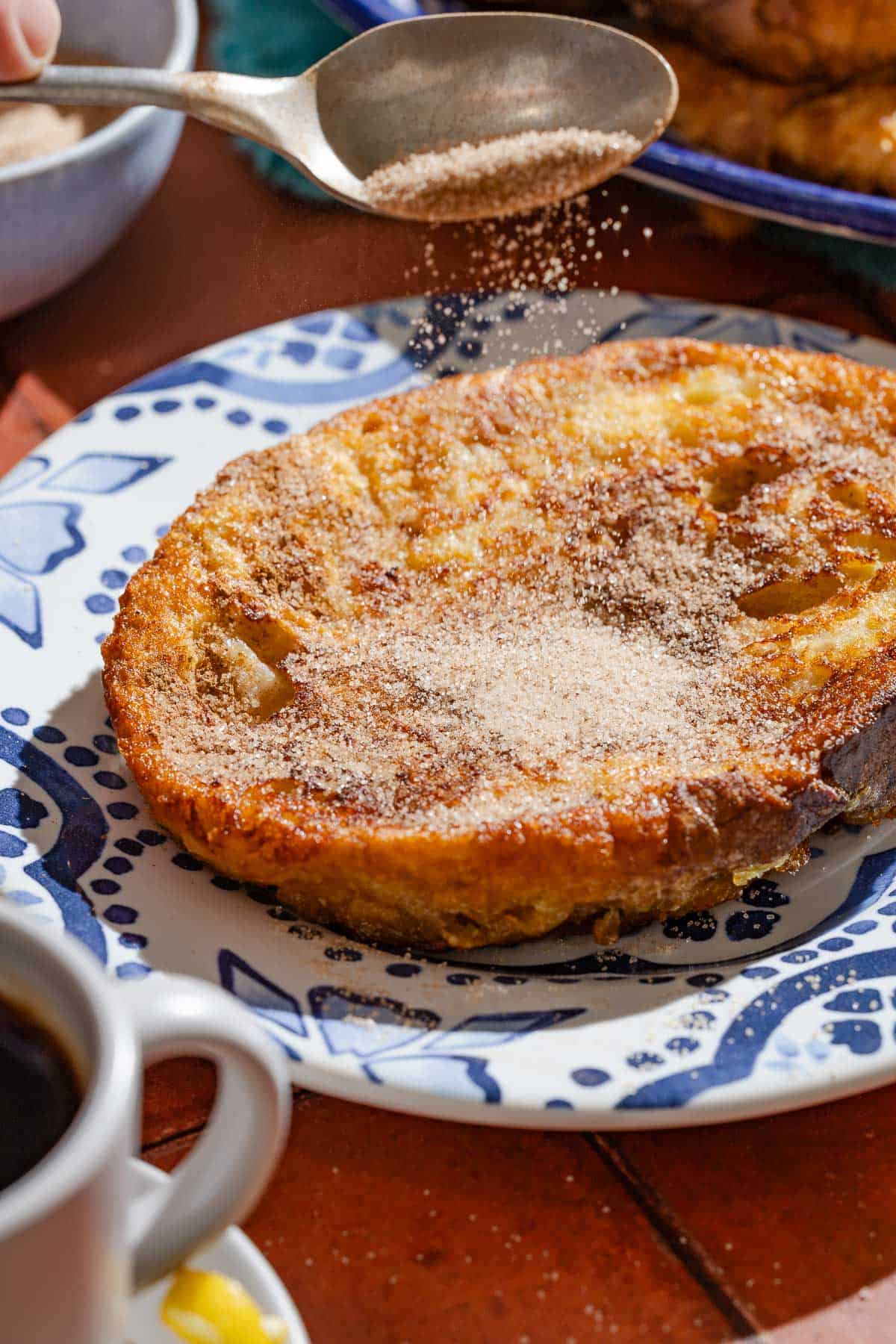
What to Serve with Torrijas
Torrijas are most often cooked at home during Semana Santa and served on their own for dessert, but you can find them in bakeries and cafes in the lead-up to Easter. Bakeries will sell them to go, which is a nice way to recharge while walking through the city to observe the Holy Week processions.
Of course, just because they’re normally eaten on their own shouldn’t stop you from serving them with some sliced fresh fruit, a spoonful of jam or some berry compote. They’re wonderful alongside a strong coffee.
You’ll Also Like: More Sweet Treats
Browse all Mediterranean recipes.
Visit Our Shop
Cook Your Torrijas in Spanish Extra Virgin Olive Oil
Bold and peppery, our Spanish olive oil is harvested from 100% Hojiblanca olives.
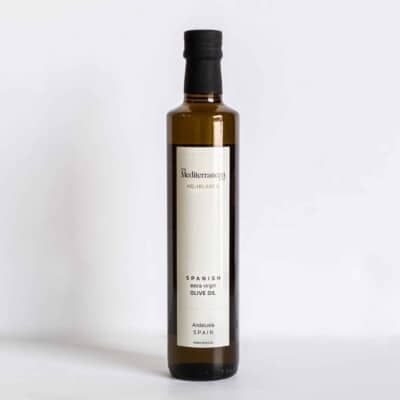
Torrijas (Spanish French Toast)
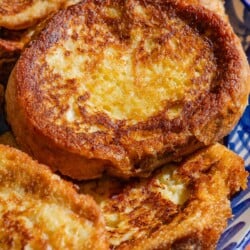
Ingredients
- 6 thick slices stale bread (see note)
- 3 cups whole milk
- 2 tablespoons honey
- 2 tablespoons granulated sugar
- 1 cinnamon stick (or substitute 1/2 teaspoon ground cinnamon)
- 2 wide strips lemon peel, orange peel, or 1 of each
- 2 large eggs
- Extra virgin olive oil, for pan frying
For Serving
- 1/2 cup granulated sugar
- 2 teaspoons ground cinnamon
- Honey, for drizzling (optional)
Instructions
- Infuse the milk: In a medium saucepan over medium heat, bring the milk, honey, sugar, cinnamon stick, and citrus peels to a simmer. Once simmering, take the pan off the heat and let cool to lukewarm, about 30 minutes. Stir the milk occasionally to prevent a skin from forming. Remove the cinnamon stick and citrus peels.
- Soak the bread: Arrange the bread slices in a single layer in a large, shallow dish or a small, rimmed sheet pan. Pour the cooled milk over the bread slices. Let rest until the bread has soaked up all of the milk, about 30 minutes.
- Meanwhile, make the cinnamon sugar topping: Combine the sugar and ground cinnamon in a small bowl.
- When the bread has soaked for 30 minutes, get ready to cook. Line a large plate with paper towels. Beat the eggs in a wide, shallow bowl. In a large nonstick pan over medium heat, heat enough olive oil to coat the bottom of the pan (about 2 to 3 tablespoons).
- Coat and cook the torrijas. Working with one slice of bread at a time, gently remove the bread from the dish and dip both sides in the beaten egg. Work carefully as the soaked bread might break apart easily. Then, place it in the hot oil to fry. Cook until golden, 1 to 2 minutes. Flip and cook the other side until golden. Transfer to the lined plate. Continue with the remaining slices of bread, coating and fry one or two slices at a time depending on the size of the pan.
- Serve. Serve the torrijas warm with a generous sprinkling of the cinnamon sugar and/or a drizzle of honey, if you’d like.
Video
Notes
- What type of bread to use? Day-old or stale bread works best for torrijas, so slices can soak up the milk without breaking apart. You can use any type of bread, but crusty white bread with a fine crumb works best.
- If you only have fresh bread: Dry the slices at 300°F for 10 to 15 minutes.
- Best way to get long strips of citrus: Use a vegetable peeler to peel a thin, wide strip. Scrape off any of the bitter white piths with a paring knife.
- What type of milk to use? I love the creaminess of whole milk, but low fat or plant-based milks work well too. For a vegan option, whisk together 1/4 cup chickpea flour and 1/4 cup water until smooth and use in place of the egg.
- Visit our shop to browse quality Mediterranean ingredients including olive oils, honey, jams, and spices.

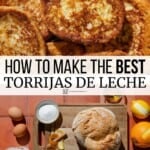
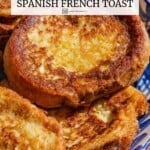
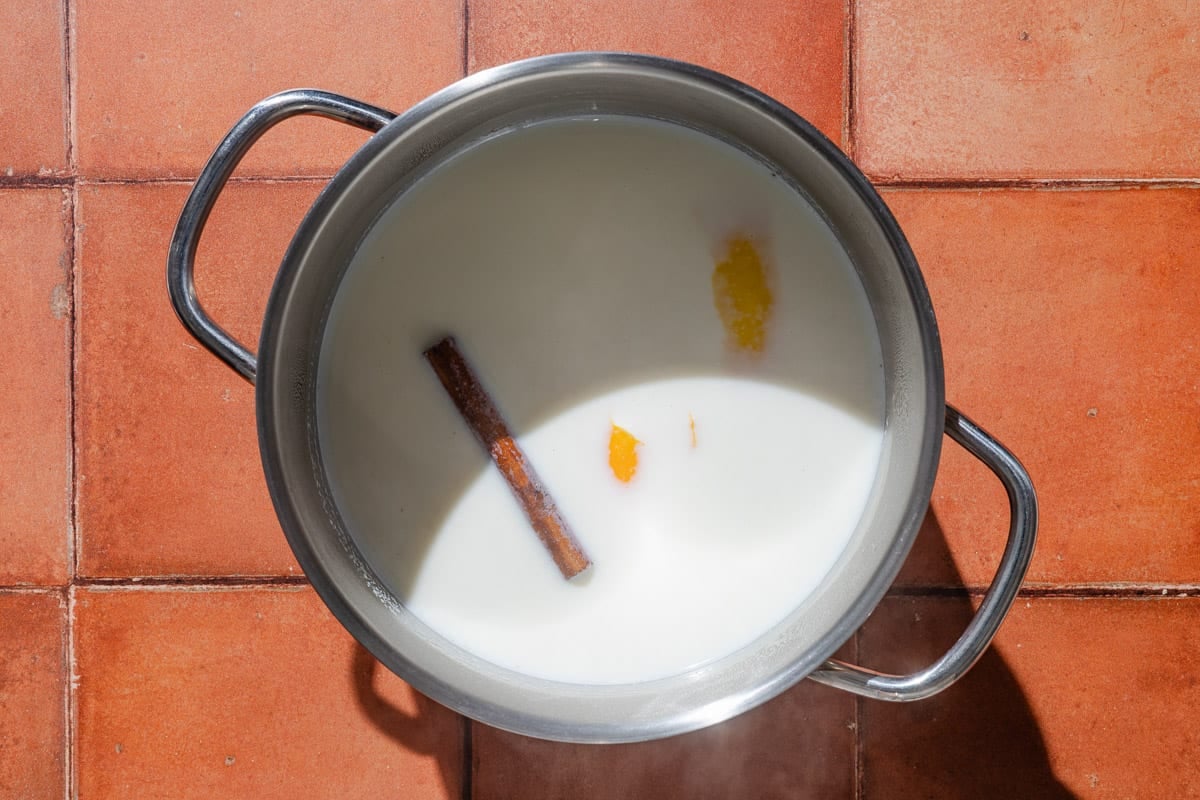
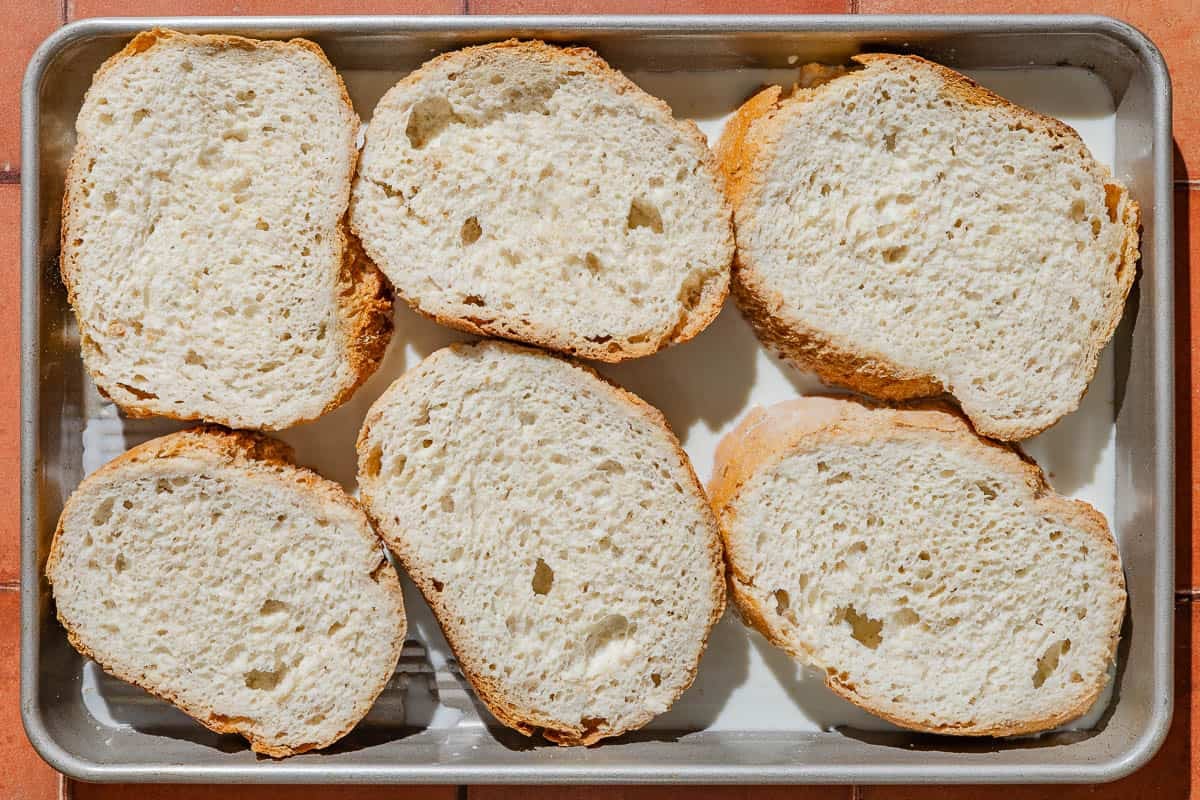
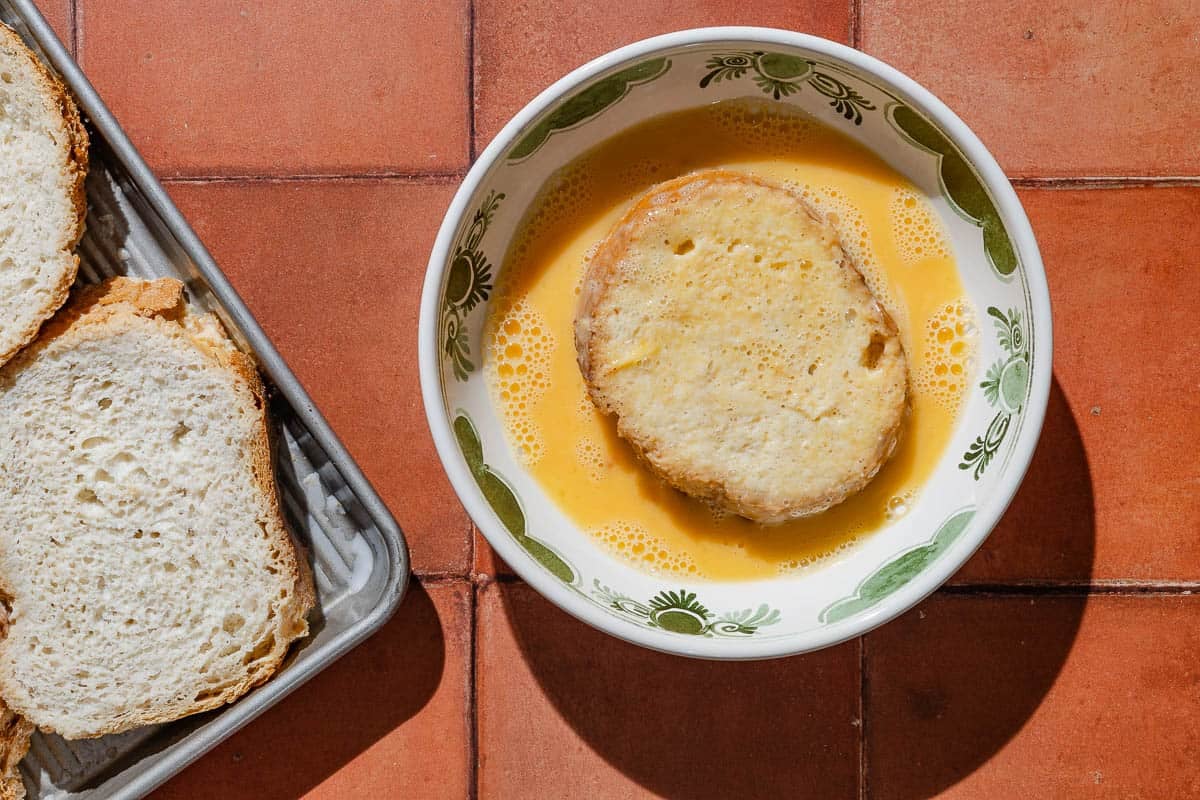
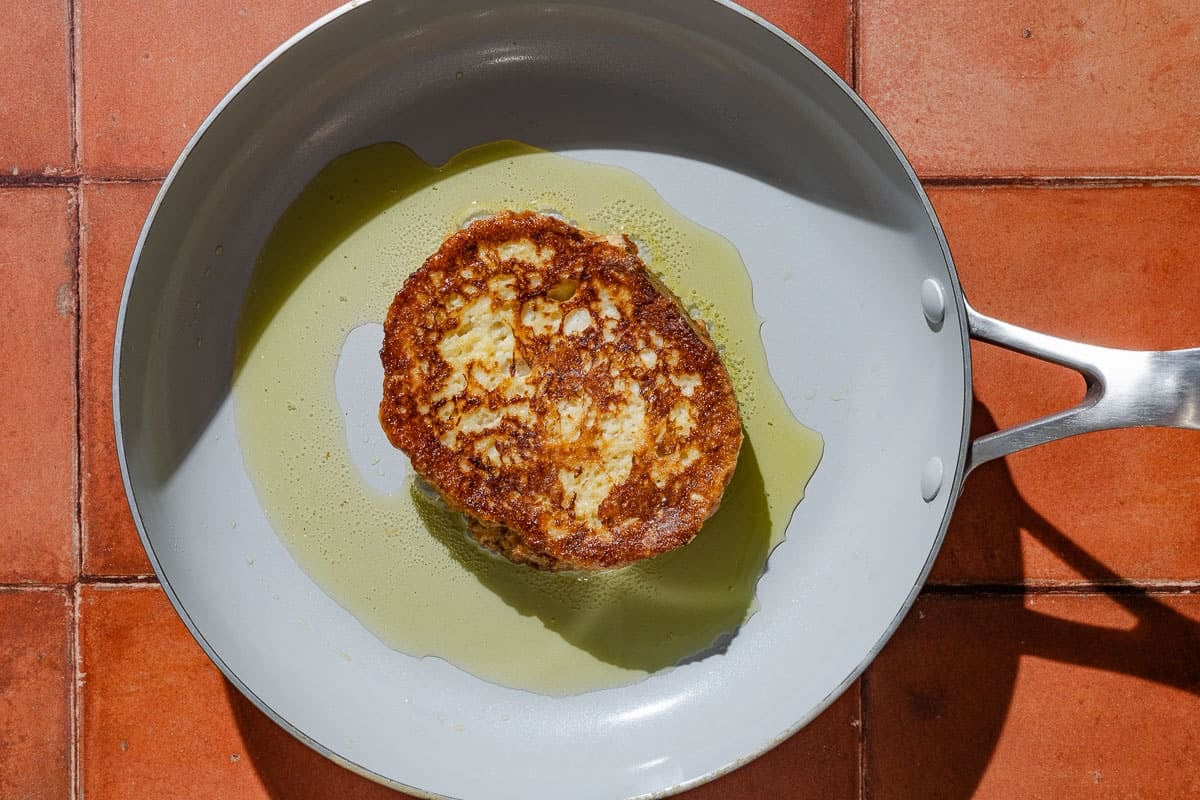
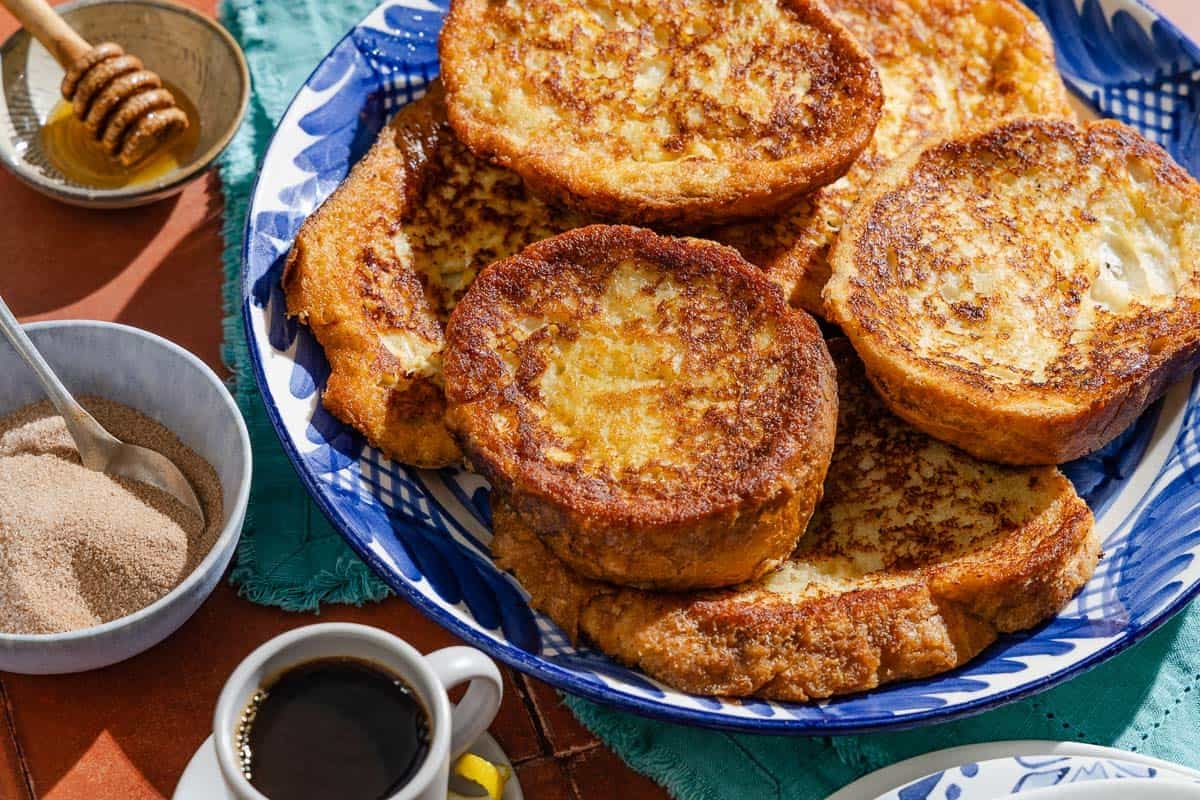
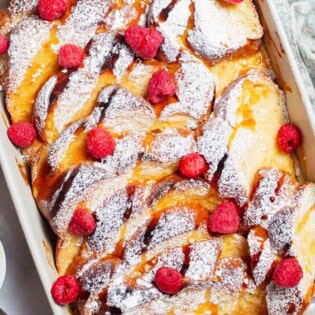
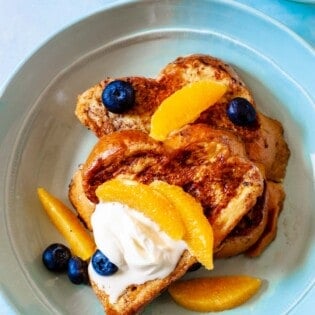
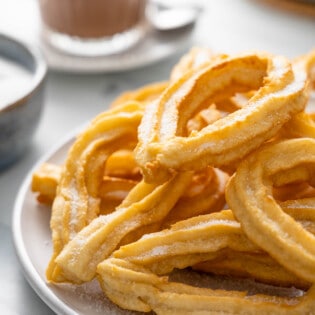
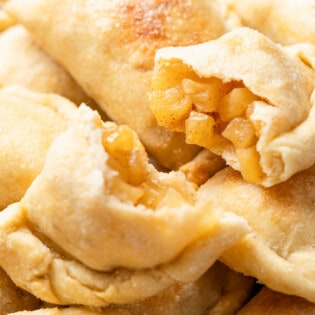
My granddaughter and I made these last year when we went to the lake house. We will be making it again this weekend. Question, can you make the milk infusion the night before and use it the next morning to save time. We Loved your recipe. Thank You !
Hi, Jeanette. That’s not something we’ve tried ourselves, but I think it would be fine. Just be sure to let the infusion cool a bit before covering and placing in the fridge. If you give this a try, please stop back and let us know how it went!!
This took some time to prepare, but was well worth it. So good!
This recipe is amazing! Very rich and filling. Love the citrus undertones from the infused milk. This is a keeper in our household.
Yay! That’s great to hear. Thanks, Carla!